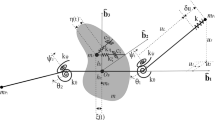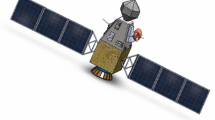Abstract
In this paper, a dynamics equation for Spacecraft has first been created using vector mechanics. Second, several attitude dynamics equations of spacecraft have been deduced. Third, a simulation of the coupled structure vibration–attitude dynamics evolution of China Space Station has been researched. Simulation results reveal the generating mechanism and evolutive law of the coupled structure vibration–attitude dynamics of spacecraft. Finally, a simplified experimental platform has been set up, and the experimental results verify the structure vibration–attitude dynamics evolution of the spacecraft and proposed experimental setup.















Similar content being viewed by others
References
Yang J, Qu S, Lin J, Liu Z, Cui X, Wang C, Zhang D, Zhou L, Chen G (2015) Research progress of the structure vibration–attitude coordinated control of spacecraft. Intl J Aeronaut Sp Sci 16(4):112–121
Ding S (2014) Non-smooth attitude stabilization of a flexible spacecraft. IEEE Trans Aerosp Electron Syst 50(2):1163–1181
Baozeng Y, Lemei Z (2014) Hybrid control of liquid-filled spacecraft maneuvers by dynamic inversion and input shaping. AIAA J 52(3):618–626
Du H, Li S (2014) Attitude synchronization control for a group of flexible spacecraft. Automatica 50(2):646–651
Hu Q, Li B, Huo X, Shi Z (2013) Spacecraft attitude tracking control under actuator magnitude deviation and misalignment. Aerosp Sci Technol 28(1):266–280
Zhang Y, Zhang JR (2013) Combined control of fast attitude maneuver and stabilization for large complex spacecraft. Acta Mech Sin Xuebao 29(6):875–882
Hu Q, Xiao B (2012) Intelligent proportional-derivative control for flexible spacecraft attitude stabilization with unknown input saturation. Aerosp Sci Technol 23(1):63–74
Hu Q, Xiao B, Friswell MI (2012) Fault tolerant control with Hinfin performance for attitude tracking of flexible spacecraft. IET Control Theory Appl 6:1388–1399
Hu Q, Zhang Y, Huo X, Xiao B (2011) Adaptive integral-type sliding mode control for spacecraft attitude maneuvering under actuator stuck failures. Chin J Aeronaut 24(1):32–45
Malekzadeh M, Naghash A, Talebi HA (2011) A robust nonlinear control approach for tip position tracking of flexible spacecraft. IEEE Trans Aerosp Electron Syst 47(4):2423–2434
Yeh F-K (2010) Sliding-mode adaptive attitude controller design for spacecrafts with thrusters. IET Control Theory Appl 4(7):1254
Azadi E, Eghtesad M, Fazelzadeh S, Azadi M (2012) Vibration suppression of smart nonlinear flexible appendages of a rotating satellite by using hybrid adaptive sliding mode/Lyapunov control. J Vib Control 19(7):975–991
Erdong J, Zhaowei S (2010) Passivity-based control for a flexible spacecraft in the presence of disturbances. Int J Non Linear Mech 45(4):348–356
Hu Q, Zhang J (2016) Attitude control and vibration suppression for flexible spacecraft using control moment gyroscopes. J Aerosp Eng 29(1):04015027
Hu Q (2009) Robust adaptive sliding mode attitude maneuvering and vibration damping of three-axis-stabilized flexible spacecraft with actuator saturation limits. Nonlinear Dyn 55(4):301–321
Qinglei Hu, Xiao Bing (2011) Robust adaptive backstepping attitude stabilization and vibration reduction of flexible spacecraft subject to actuator saturation. J Vib Control 17(11):1657–1671
Hu QL, Cao J, Zhang YZ (2009) Robust backstepping sliding mode attitude tracking and vibration damping of flexible spacecraft with actuator dynamics. J Aerosp Eng 22(2):139–152
Song X-J, Yue B-Z, Wu W-J (2015) Investigation on attitude disturbance control and vibration suppression for fuel-filled flexible spacecraft. Acta Mech Sin 31(4):581–588
Chu Z, Cui J, Ren S, Ge SS (2015) Semi-physical experimental study of adaptive disturbance rejection filter approach for vibration control of a flexible spacecraft. Proc Inst Mech Eng Part G J Aerosp Eng 229(11):2085–2094
Yue B-Z (2011) Study on the chaotic dynamics in attitude maneuver of liquid-filled flexible spacecraft. AIAA J 49(10):2090–2099
Yue B, Song X (2011) Heteroclinic bifurcations in attitude maneuver of coupled slosh-spacecraft with flexible appendage. Sci China Technol Sci 54(8):2090–2099
Shahravi M, Azimi M (2015) A comparative study for collocated and non-collocated sensor/actuator placement in vibration control of a maneuvering flexible satellite. Proc Inst Mech Eng Part C J Mech Eng Sci 229(8):1415–1424
Zhang Y, Xu S (2011) Vibration isolation platform for control moment gyroscopes on satellites. J Aerosp Eng 25(4):641–652
Hu Q, Zhang J (2015) Maneuver and vibration control of flexible manipulators using variable-speed control moment gyros. Acta Astronaut 113:105–119
Ni Z, Mu R, Xun G, Wu Z (2016) Time-varying modal parameters identification of a spacecraft with rotating flexible appendage by recursive algorithm. Acta Astronaut 118:49–61
Chen T, Wen H, Hu H, Jin D (2016) Output consensus and collision avoidance of a team of flexible spacecraft for on-orbit autonomous assembly. Acta Astronaut 121:271–281
Yang D, Yue B (2013) Attitude manoeuvre of spacecraft with long cantilever beam appendage by momentum wheel. Int J Control 86(2):360–368
Ayoubi MA, Sendi C (2013) Takagi-Sugeno fuzzy model-based control of spacecraft with flexible appendage. J Astronaut Sci 61:1–21
Sales TP, Rade DA, De Souza LCG (2013) Passive vibration control of flexible spacecraft using shunted piezoelectric transducers. Aerosp Sci Technol 29(1):403–412
Lee KW, Singh SN (2012) L1 adaptive control of flexible spacecraft despite disturbances. Acta Astronaut 80:24–35
Azadi M, Fazelzadeh SA, Eghtesad M, Azadi E (2011) Vibration suppression and adaptive-robust control of a smart flexible satellite with three axes maneuvering. Acta Astronaut 69(5):307–322
Maganti GB, Singh SN (2007) Simplified adaptive control of an orbiting flexible spacecraft. Acta Astronaut 61(7–8):575–589
Malekzadeh M, Naghash A, Talebi H (2010) Control of flexible spacecraft using dynamic inversion and u-synthesis. J Vib Control 17(13):1938–1951
Loria A, Espinosa-Perez G, Avila-Becerril S (2014) Global adaptive linear control of the permanent-magnet synchronous motor. Int J Adapt Control Signal Process 28:971–986
Azadi M, Eghtesad M, Fazelzadeh SA, Azadi E (2015) Dynamics and control of a smart flexible satellite moving in an orbit. Multibody Syst Dyn 35:1–23
Sendi C, Ayoubi MA (2016) Robust-optimal fuzzy model-based control of flexible spacecraft with actuator constraints. J Dyn Syst Meas Control 138:091004
Zhong C, Guo Y, Yu Z, Wang L, Chen Q (2016) Finite-time attitude control for flexible spacecraft with unknown bounded disturbance. Trans Inst Meas Control 38(2):240–249
Xiao B, Hu Q, Wang D (2015) Spacecraft attitude fault tolerant control with terminal sliding-mode observer. J Aerosp Eng 28(1):04014055
Wu S, Radice G, Sun Z (2014) Robust finite-time control for flexible spacecraft attitude maneuver. J Aerosp Eng 27:185–190
Pukdeboon C (2014) Adaptive-gain second-order sliding mode control of attitude tracking of flexible spacecraft. Math Probl Eng 2014:312494
Liu H, Guo L, Zhang Y (2012) An anti-disturbance PD control scheme for attitude control and stabilization of flexible spacecrafts. Nonlinear Dyn 67(3):2081–2088
Hu Q (2012) Adaptive nonlinear proportional-derivative type fault tolerant control for flexible spacecraft attitude maneuvers under bounded disturbances. J Aerosp Eng 25(2):178–190
Acknowledgements
This project is supported by National Natural Science Foundation of China (Grant no. 51605308) “Co-evolution of fractional order coupled structure vibration–attitude dynamic and control of spacecraft”; The Liaoning Province doctor Science Research Fund Project “Co-evolution of fractional order coupled structure vibration–attitude dynamic and control of China Space Station”(Grant no. 201601178); The Liaoning Province “13th Five Year Plan” Higher Education Research Fund Project “Teaching quality monitoring system and safeguard mechanism research on Aerospace engineering majors” (Grant no. GHZD160012); The Liaoning Province Department of Education Fund Project “Study of fractional order coupled structure vibration–attitude dynamic and control of spacecraft” (Grant no. L2015414); The Liaoning Province Department of Education Fund Project “Research and practice on specialty of aerospace engineering based on recognition for engineering education”(Grant no. 030201619);“Exploration and Practice of ‘Theory+Interesting+Research’ Innovative Teaching Mode”(Grant no. YJS2014-11); “Reform and Practice of ‘Theory+Interesting+Research’ Innovative Teaching Mode”(Grant no. JG2017011); “Research on Intelligent Integrated Control of Coupling between Space Solar Power Station Structure Vibration and Attitude Control (Grant no. 13YB22)”.
Author information
Authors and Affiliations
Corresponding author
Rights and permissions
About this article
Cite this article
Yang, J., Liu, F. Coupled Structure Vibration–Attitude Dynamics Evolution and Control of China’s Space Station. Int. J. Aeronaut. Space Sci. 20, 126–138 (2019). https://doi.org/10.1007/s42405-018-0124-1
Received:
Revised:
Accepted:
Published:
Issue Date:
DOI: https://doi.org/10.1007/s42405-018-0124-1




